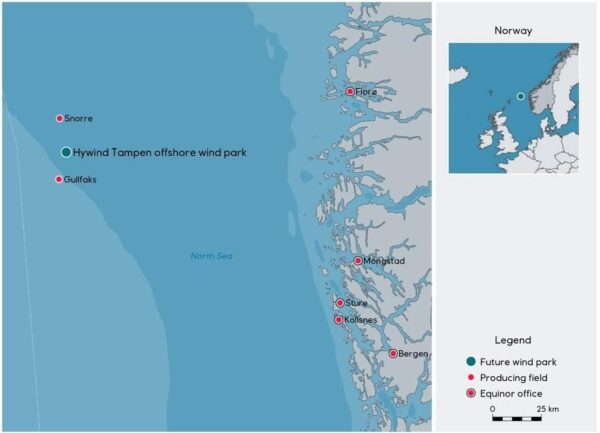Hywind Tampen, the world’s largest floating offshore wind farm, was inaugurated by Equinor and its partners. Hywind Tampen consists of 11 8.6 megawatt (MW) turbines. It’s around 140 km (87 miles) off the Norwegian coast in a water depth of between 260 and 300 metres (853 to 984 feet). It produced its first power in November last year and reached full output earlier this month.
It is the world’s first floating wind farm built specifically to power offshore oil and gas installations, and is now supplying electricity to Equinor’s oil and gas fields Snorre and Gullfaks in the Norwegian North Sea.
Powering the oil and gas industry
Equinor’s 94.6 MW, €488 million ($522 million) project will provide electricity for the Snorre and Gullfaks oil and gas fields in the Norwegian North Sea. It’s expected to meet around 35% of the five platforms’ annual power needs.
Equinor asserts that Hywind Tampen will reduce the need for locally produced gas power and “thus reduce annual emissions from the fields by about 200,000 tonnes of CO2, which is equivalent to emissions from 100,000 vehicles.”
Norway is the world leader in electric cars per capita. It’s planning 30 GW of offshore wind by 2040. But the Scandinavian country is also Western Europe’s largest oil and gas producer. The petroleum sector makes up around 40% of Norway’s exports and 14% of its gross domestic product.
The use of a floating wind farm to help power the fossil fuel industry is likely to spark significant debate. The Norwegian government says it will work to cut the country’s net emissions by 55% by 2030 from 1990 levels. That’s aligned with EU targets. But unlike its EU neighbours, Norway says its move to clean energy will be gradual and that it has no intention of giving up oil and gas exploration.
Calling the opening a “historic day”, Prime Minister Jonas Gahr Stoere said the initiative would help Norway cut its CO2 emissions and that abruptly stopping oil and gas was not the solution in the energy transition.
“The world will continue to need gas and oil in this transitional phase. This is not a cut-off from one day to the other. So we have to minimise the footprint,” Stoere told Reuters.
Hywind Tampen comprises wind turbines fixed to a floating base that is anchored to the sea floor, rather than fixed to the ocean bed, a new technology industry experts say is suitable for use in deeper waters offshore that Equinor hopes to develop.
The technology is still in its infancy and costs at Hywind Tampen have risen from an initial estimate of 5.2 billion crowns ($491 million) in 2020, to 7.4 billion crowns, driven by raw material delays, quality issues, inflation, and currency effects.
Reporting on this story came from Reuters, CNBC, Electrek and Equinor.
